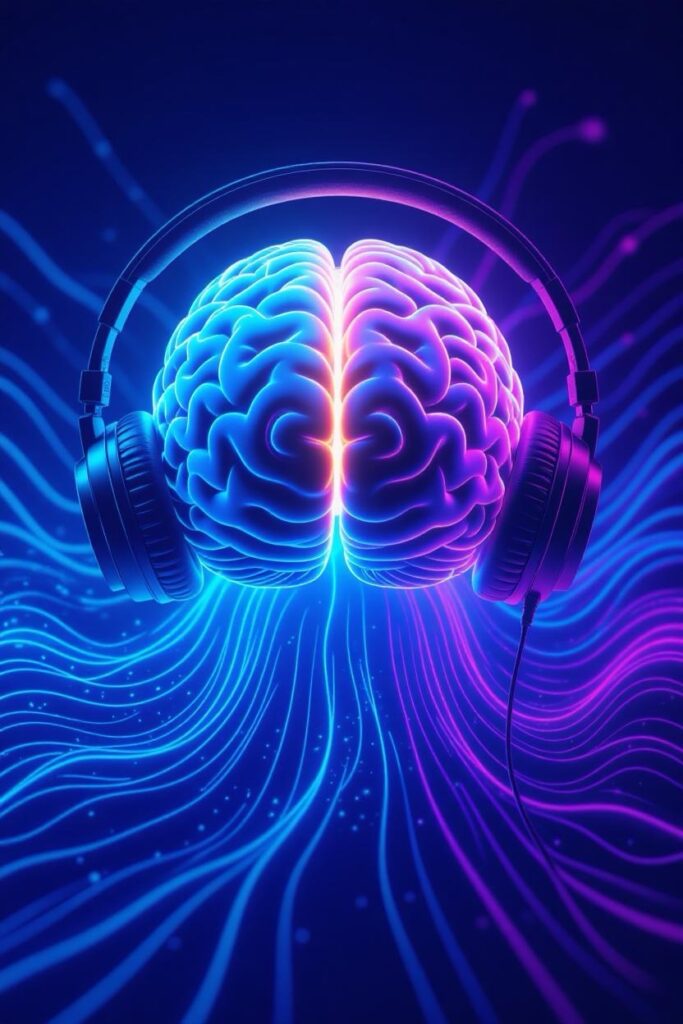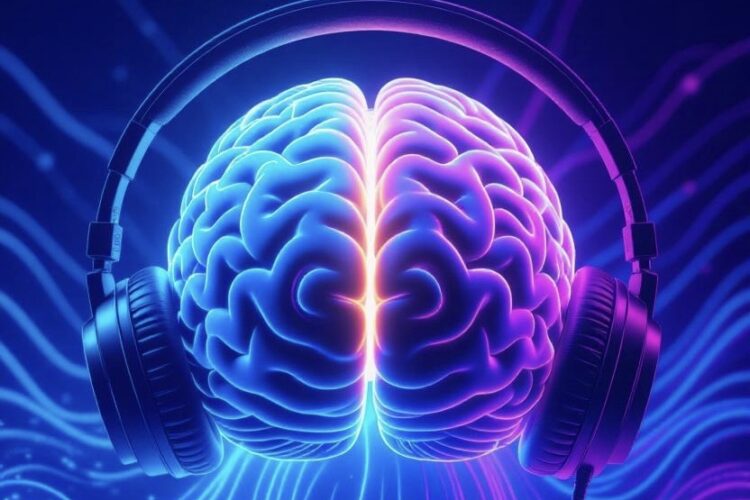Binaural beats, discovered in 1839, are an auditory illusion created when two slightly different tones are played in each ear, producing a perceived “beat” frequency (e.g., 400 Hz and 410 Hz create a 10 Hz beat). Delivered through headphones, they influence brain waves via the superior olivary complex, promoting brainwave entrainment. This can align brain activity to delta (1-4 Hz, deep sleep), theta (4-8 Hz, meditation), alpha (8-14 Hz, relaxation), beta (14-30 Hz, focus), or gamma (30-100 Hz, cognition) waves. Benefits include reduced stress, improved focus, better sleep, and pain relief, though results vary individually. Studies show mixed outcomes due to differing methods, but theta and gamma beats often enhance memory and mood. Safe for most, they may cause irritability if overused; epilepsy patients should consult doctors. Use 10-30 minute sessions with frequencies like 6 Hz for relaxation or 40 Hz for focus. Ongoing research aims to standardize findings, making binaural beats a promising, non-invasive tool for mental and emotional well-being.
Long Version
Binaural Beats: The Science, Benefits, and Applications of Brainwave Entrainment
Binaural beats represent a fascinating auditory phenomenon that has captivated researchers, musicians, and wellness enthusiasts alike since its discovery in 1839 by Prussian physicist Heinrich Wilhelm Dove. This psychoacoustic illusion occurs when two slightly different pure tones are presented dichotically—one to each ear—creating a perceived third tone or “beat” frequency that equals the difference between the two carrier frequencies, typically measured in Hertz (Hz). For instance, a 400 Hz tone in one ear and a 410 Hz tone in the other produce a 10 Hz binaural beat, often embedded in ambient music, white noise, or pink noise for enhanced listening experiences. Unlike monaural beats, which are physical acoustic beats formed by amplitude modulation in the air, binaural beats arise centrally in the brain, specifically within the superior olivary complex (SOC) in the brainstem, where neural pathways integrate auditory signals from both ears. This integration involves sound localization, phase differences, and interference patterns, leading to an illusory rotating tone or fluctuating loudness that can influence brain waves, neurons, and electrical impulses.
Dove’s initial observation marked binaural beats as a scientific curiosity, but it wasn’t until the 1970s that figures like Gerald Oster, Robert Monroe, and Itzhak Bentov advanced their study through empirical research. Oster’s work highlighted the frequency-following response (FFR), where the brain’s electrocortical activity synchronizes to the beat frequency, a process known as brainwave entrainment or synchronization. Monroe popularized their use in hypnosis, meditation, and astral projection, while Bentov explored their ties to altered states of consciousness. By the 2000s, neuroscientific research using electroencephalography (EEG), magnetoencephalography (MEG), and event-related potentials (ERPs) began to quantify these effects, analyzing spectral power, relative power, absolute power, and brain connectivity in laboratory settings.
The Neuroscientific Mechanisms Behind Binaural Beats
At its core, binaural beats leverage the brain’s auditory driving and rhythm entrainment capabilities. When two sine waves with a frequency difference of 1–30 Hz—aligning with human EEG frequency bands—are delivered via headphones or earbuds, the auditory cortex processes them as a single, oscillating percept. This diotic amplitude modulation creates an envelope or superposition principle, where the perceived audible beat frequency emerges from wave interference at the cochlear level and midbrain structures like the inferior colliculus. Neurons in these areas fire action potentials in response, modulating the reticular formation and thalamus, which relay signals to cortical regions.
The key hypothesis is the brainwave entrainment hypothesis: external stimulation via binaural beats induces systematic changes in neural activities, aligning endogenous brain waves to the beat frequency. For example, a 6 Hz beat targets theta waves (4-8 Hz), associated with meditative states, visualization, and deep relaxation. EEG studies measure this through parameters like auditory steady-state responses (ASSRs), auditory evoked potentials, and frontal midline theta activity. Research shows that binaural beats can enhance alpha-band coherence, interhemispheric coherence, and functional connectivity, particularly in parietal electrode sites, temporal electrode sites, frontal areas, central regions, and occipital areas.
However, empirical outcomes reveal inconsistency due to methodological heterogeneity. A systematic review analyzing 14 studies on healthy adults, found partial evidence for entrainment in theta, alpha, and gamma bands but no robust effects for beta or delta. Studies often use passive listening conditions with eyes open or closed, employing pure binaural beats or those embedded in pink noise, with durations from 1 to 30 minutes. Statistical analyses like paired t-tests, two-way ANOVA, mixed-design ANOVA, and repeated measures ANOVA assess changes in normalized spectral power, phase locking, and cross-frequency responses. Yet, factors such as individual differences, stimulation technique thresholds, and carrier frequencies (e.g., maximum 1000 Hz for optimal perception) contribute to varying results. For instance, lower carrier tones (e.g., 250 Hz) elicit stronger responses than higher ones (e.g., 1 kHz), and noise embedding often yields no entrainment.
Recent research reinforces this. A parametric investigation varied BB parameters and found mixed effects on sustained attention and entrainment. Another study on 6 Hz BBs over one month using ERPs showed increased P300 amplitude and shorter latencies in auditory tasks, indicating enhanced cognitive processing after daily 10-minute sessions. Beta-frequency BBs (15 Hz) combined with music improved recovery in athletic performance, while gamma-domain stimulation (40 Hz) supported cognitive enhancement.
Brain Waves and Their Modulation
Human brain waves, recorded via electrodes on the scalp, reflect electrical signals from thoughts, emotions, and behaviors. They are categorized into major EEG frequency bands:
- Delta waves (1-4 Hz): Linked to deep sleep, transcendence, restoration, and healing. Binaural beats in the delta range promote REM sleep, daytime naps, and parasympathetic activation, reducing cortisol and aiding anti-aging effects.
- Theta waves (4-8 Hz): Associated with dreaming, trance, creativity, problem-solving, and inner peace. Theta entrainment enhances visuospatial working memory, memory recall, and state of flow, with effects on theta rhythm and frontal midline theta activity.
- Alpha waves (8-14 Hz): Tied to relaxation, positive thinking, alertness, and meditative states. Alpha entrainment boosts positivity, reduces distractions, and improves mood.
- Beta waves (14-30 Hz): Related to concentration, analytical thinking, arousal, and increased energy. Beta frequencies support cognitive activities, intelligence tests, and deeper concentration.
- Gamma waves (30-100 Hz): Involved in peak experiences, synchronization, high-level cognition, and multi-processing. Upper gamma stimulation aids memory retention and emotional states.
Binaural beats target these bands to alter cognitive states, affective states, and physiological states. For example, 40 Hz gamma beats evoke ASSRs, while 7 Hz theta beats change relative theta power. Intracranial EEG and Higuchi fractal dimension analyses further reveal cortical connectivity shifts.
Benefits and Applications
Binaural beats offer a complementary strategy for mental health and cognitive performance, with applications in diverse fields. They reduce stress, anxiety, and depression by promoting sympathetic withdrawal and autonomic nervous system balance, as seen in pre-operative anxiety and fibromyalgia management. For focus and productivity, beta and gamma beats enhance alertness, working memory, and problem-solving, with one study showing a 27% long-term memory improvement. Sleep benefits include deeper sleep, improved sleeping habits, and reduced hyperarousal, particularly with delta and theta ranges.
In pain management, BBs alter pain perception through brain stimulation, effective for chronic pain and post-exercise recovery. Creative states and ASMR experiences are amplified, often integrated into study music or hypnosis sessions. Psychiatric disorders benefit from mood modulation and positive moods. Musicians, including Alvin Lucier, Giacinto Scelsi, Phill Niblock, and those using pipe organs or voix céleste, incorporate microtonal oscillations and zero-beating for artistic effects.
Personal experiences vary: some report boosted memory and focus with 40 Hz beats, while others note quick sleep induction or pain relief. However, effectiveness is interindividual, with apps noting only 43% respond based on EEG.
Randomized controlled trials and meta-analyses support these in controlled and uncontrolled studies, from emergency departments to ecological valid settings. For tinnitus, BBs provide relief, and in anesthesia, they reduce anxiety. Quality of life improvements include better emotional arousal, hypnotic susceptibility, and item/source memory.
Potential Side Effects and Usage Guidelines
While generally safe, binaural beats may cause irritability, frustration, or decreased performance in cognitive tasks if overused. High decibel levels risk hearing loss, and those with epilepsy should consult professionals due to rhythmic stimulation. No major side effects like brain damage are reported, but monitor for changes in dehydroepiandrosterone (DHEA) or unconscious mind influences.
To use effectively: Employ headphones for dichotic presentation, start with 10-30 minute sessions via MP3 players or mobile devices. Opt for frequencies like 6 Hz theta for daily cognitive boosts or 40 Hz gamma for focus. Combine with isochronic tones or acoustic beats for variety. Consistency is key for cumulative effects.
Future Directions and Conclusions
As of October 2025, ongoing research emphasizes standardization in experimental designs, EEG analyses, and study approaches to resolve inconsistencies. Preregistered studies with larger, diverse samples—including neurological samples and various cultural backgrounds—will enhance generalizability. While pseudoscientific contexts persist, sound evidence positions binaural beats as a valuable tool for psychological and physiological functioning, from basic acoustic research to clinical diagnostics. Caution remains warranted, but their non-invasive nature offers a promising avenue for enhancing mental states without traditional treatments.

Hashtags For Social Media
#BinauralBeats #BrainwaveEntrainment #MeditationMusic #RelaxationSounds #ThetaWaves #AlphaWaves #DeltaSleep #GammaFocus #BetaAlertness #SoundHealing #FrequencyHealing #SleepAid #FocusBoost #StudyBeats #AnxietyRelief #StressReduction #MindfulnessMeditation #SpiritualVibes #HealingFrequencies #AmbientRelax #ChillMusic #YogaFlow #AstralJourney #LucidDreams #PositiveEnergy #MentalWellness #SelfCareRoutine #EnergyBalance #VibrationalHarmony #BrainSync
Related Questions, Words, Phrases
what are binaural beats | how do binaural beats work | binaural beats benefits | best binaural beats frequencies | do binaural beats really work | binaural beats for sleep | binaural beats side effects | history of binaural beats | binaural beats vs isochronic tones | how to use binaural beats effectively | binaural beats for anxiety relief | scientific evidence for binaural beats | binaural beats brainwave entrainment explained | free binaural beats apps | binaural beats for focus and concentration | dangers of listening to binaural beats | binaural beats theta waves meditation | gamma binaural beats for cognition | delta binaural beats deep sleep | alpha binaural beats relaxation techniques | binaural beats pain management studies | how binaural beats affect brain waves | binaural beats for creativity boost | beginner guide to binaural beats | binaural beats eeg research findings | make your own binaural beats | binaural beats for depression treatment | binaural beats asmr experiences | binaural beats in music production | binaural beats epilepsy warnings | long-term effects of binaural beats | binaural beats for memory improvement | binaural beats vs white noise for studying | binaural beats astral projection tips






